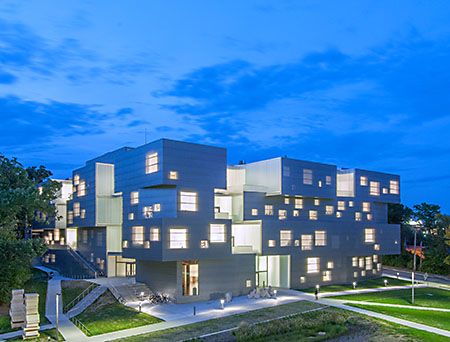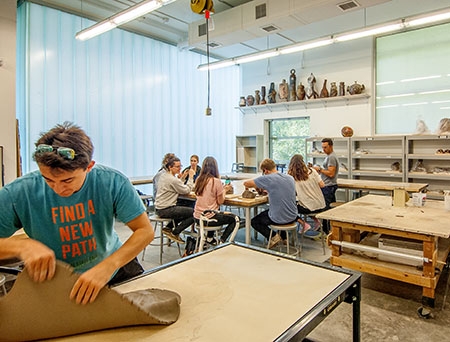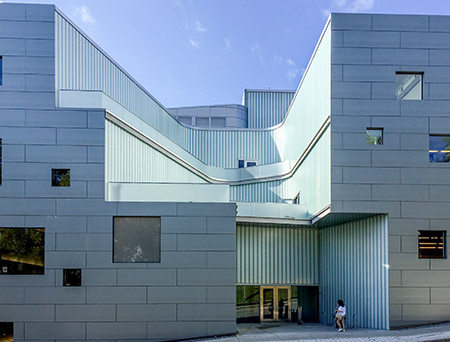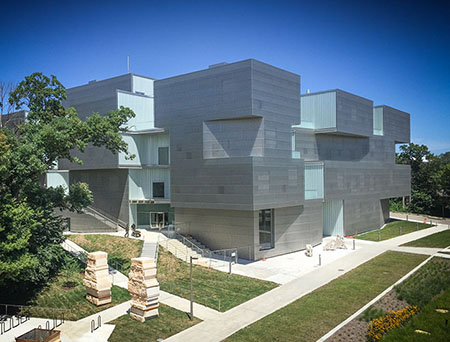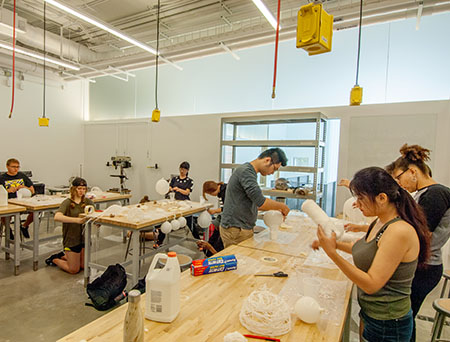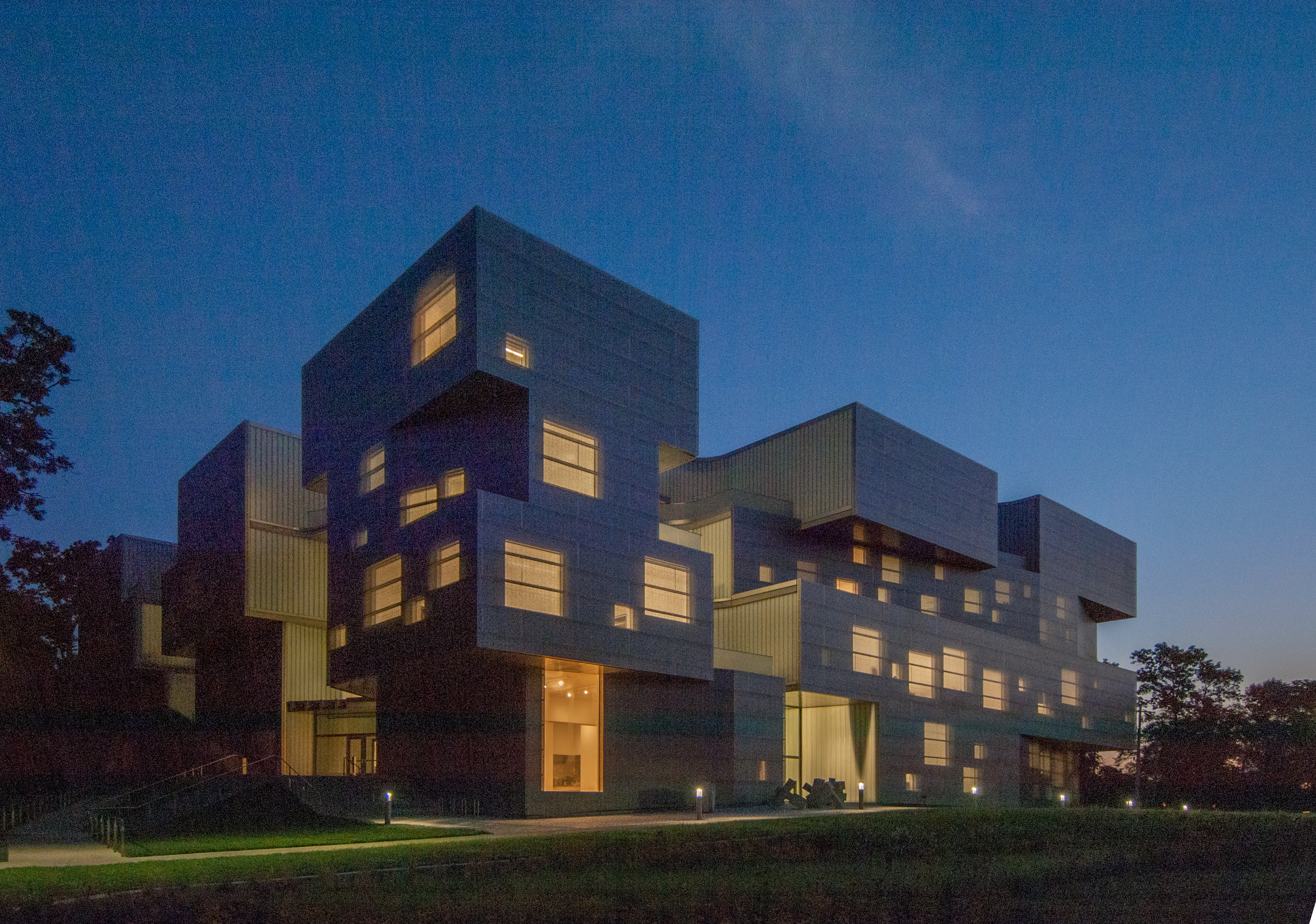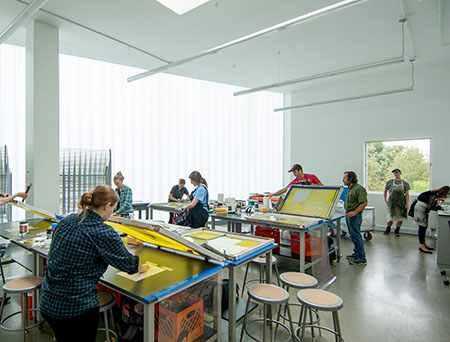Visual Arts Building
University of Iowa, Iowa City
Project History
This project provides a new 126,000 square foot home for the University of Iowa School of Art to replace the existing studio arts facility that was lost to a flood in 2008. The building will provide studio arts space, including sculpture, metals and jewelry, ceramics, printmaking painting and drawing, intermedia and 3D design studios, gallery space, large and small classroom space, auditorium space, seminar space and administrative support space.
Design Engineers collaborated closely with the architects at both Steven Holl and BNIM to integrate the mechanical and electrical systems into the context of the overall design concept. Design Engineers also worked closely with the other specialty design professionals, as follows, to determine the best solutions for each application:





We have been blessed with terrific architects – Holl Architects – and have a beautiful building that inspires art production. And, when we walk in day one, fall 2016, our curricular program will thrive, because of Design Engineers’ successful engineering of the building. My observation is that, like me, the architects believe Amy and Design Engineers to be in a league of their own. They work well with both architects and users and inspire confidence across the design team with knowledge, thoroughness and consultation. Steve McGuire, School of Art & Art History, University of Iowa
The project includes a four-story atrium winding through the building enclosed at the top by a large skylight. The skylight is provided with a fixed shading device that is designed to admit the optimum amount of daylight while minimizing the amount of solar gain in the atrium area. The project team code consultant provided CFD modeling to optimize the design of the atrium smoke control system, which in turn allowed Design Engineers to minimize the impact of the smoke control system on the aesthetics of the featured atrium space.
Due to the complex geometry of the atrium and the unique application of some of the systems, thermal modeling was used to inform the cooling and heating system design, including the design of a natural ventilation system within the atrium.
With regard to the other aspects of our design review, overall the 100% construction documents are excellent (probably some of the best design documents we have ever reviewed). We have very few comments from our review and we would consider our comments to be minor in nature. The design concepts are clear, easy to follow and well detailed. Coordination between disciplines and systems integration far exceeds what we typically see on documents we review. The control sequences of operation are also well defined. The documents contain sufficient information regarding the systems installations and control sequences of operation for SSRCX to begin developing the commissioning plan. SSRCX Facilities Commissioning
HVAC System Design
One of the unique features of the project is its heating system. All of the heat required for the building is provided by harvesting waste heat from the building’s core and from other the campus buildings. Heat recovery chillers are used to extract heat from the campus chilled water system. A byproduct of this process is chilled water which is returned to the campus chilled water loop which in turn allows it to be used in other buildings.
The heating, ventilating and air conditioning strategy implements a combination of three systems:
- An activated slab heating and cooling system consisting of PEX piping poured into the underside of the slab. The slab heating and cooling system is essentially a passive system with minimal active control. There is no insulation installed in the concrete so that the thermal mass of the concrete is part of the system. The routing of the PEX piping required close coordination with the voids within the structural slab.
- Supplemental heating and cooling systems in the form of ventilation air cooling via variable air volume terminal units, radiant perimeter heat installed in the slab and fan coil units.
- Exhaust and outdoor air systems to provide exhaust as required per code and by equipment and processes and outdoor air as required for replacement air for exhaust systems, ventilation air for compliance with ASHRAE 62.1 indoor air quality standard and pressurization air to maintain the building positive relative to outside.
In addition, a single zone displacement ventilation system is provided to serve the 76-seat classroom. The displacement ventilation system is utilized because this system supplies air at a low velocity which is very quiet and only conditions the occupied zone closest to the floor, thus reducing the amount volume that needs to be conditioned as well as reducing the outdoor air required for ventilation.
Specialized Air Handling Unit Supply and Exhaust Systems
The outdoor air provided for both ventilation and replacement air is pretreated by a custom air handling unit with separate sensible heat pipe and total energy recovery wheel air streams.
To address the special requirements of the wide variety of systems required to support the many challenging processes that occur in a Studio Arts environment, Design Engineers collaborated closely with the users throughout the design process. Several different specialty exhaust systems are provided in support of the specialized processes that occur in the foundry, metals and jewelry, painting, printmaking and ceramics, including fume hoods, exhaust hoods, snorkels and dust collection systems for woodworking, glazing and metals working processes. Other specialty systems provided include compressed air, natural gas, acetylene, domestic hot and cold water, pure water and acid waste and vent.
All of the mechanical systems are controlled by a direct digital control building automation system.
Electrical Design
The electrical distribution has been specifically designed to mitigate arc-flash hazard ratings. SKM, a power systems modeling software, was used by the design team to conduct multiple preliminary studies to determine the most effective solution and work within the space allocations available. The system is a 3000A, 277/480V service with K-rated dry type transformers for stepping down to 120/208V panel boards. The distribution system also includes a natural gas generator for emergency systems within the building.
An extensive sub-metering system was provided to meter general use lighting, plug loads and HVAC loads. These meters have been designed to integrate with the buildings temperature controls system for logging and trending energy usage. This will allow the Owner to determine where energy savings can be captured as well as help identify if a system is not working as intended.
Lighting System Design
The lighting design includes unique applications and distinctive installation details for standard products that provide a custom appearance. Lighting power densities were reduced to 30% below current energy standards and still met the minimum lighting requirements of IESNA.
Many fixtures in the building utilize LED technology, both for their reduced wattage capability as well as for their long life. Special attention was given to fixture maintenance to assure fixtures are accessible in the future and repairable. Many of the high volume spaces in the building presented lighting challenges that were solved in unique ways.
The networked lighting control system is an addressable system with a graphical user interface and is integrated with the building automation system. The lighting controls are flexible and customizable with capabilities for both local and remote programming. Much of the floor plan was designed to allow natural light to flow through the building, light fixtures that fall within these zones are controlled for automatically dimming to the natural light available.
Fire Protection Design
The many specialty processes that occur in studio arts required close coordination with the code consultant to ensure compliance with all required codes. To maintain the desired aesthetics, specific routing is indicated for all sprinkler piping.
The fire alarm system provides voice notification throughout the facility and is integrated with the atrium smoke control panel and the dry sprinkler system provided for the loading dock.
BIM Coordination
The unique layout of the building combined with the character of the high loft like open spaces required close coordination of all of the mechanical and electrical systems. Revit was used extensively for modeling the complex structure of the building and 3D views were included in the finals plans to help convey the required scope of work.
Download the Project Case Study: ![]() UI Art Building Replacement
UI Art Building Replacement
Project Awards
2017 ENR Awards – Higher Education Best Project
2016 Interior Design – Best of the Year Award: Education
2016 Architect’s Newspaper – Building of the Year Award: Midwest
2017 AIANY Honor Award
2017 Chicago Athenaeum – American Architecture Prize


